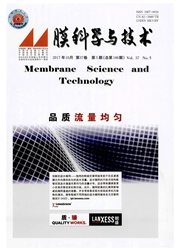

 中文摘要:
中文摘要:
研究了陶瓷膜微滤Ti O2-PAM(聚丙烯酰胺)悬浆液体系,分析了微滤过程的膜阻力Rm、滤饼层阻力Rc和孔阻力Ri,并考察了反冲、湍流促进器的强化作用和相应的有效清洗方法.研究结果表明,微滤Ti O2悬浆液总阻力以膜自身阻力Rm为主,其次为滤饼层阻力Rc,反冲和湍流促进器均能显著降低微滤阻力,采用物理机械法和0.1 mol/L的HNO3溶液化学法均能有效实现膜清洗;微滤PAM水溶液及PAM-Ti O2悬浆液体系的总阻力以孔阻力Ri为主,其次为凝胶层阻力Rc,湍流促进器可有效降低微滤阻力,采用0.1 mol/L的HNO3溶液、0.1mol/L的NaOH溶液和质量分数1%H2O2溶液的组合清洗工艺,可使膜通量恢复率达到96.5%.
 英文摘要:
英文摘要:
This work investigated the application of ceramic membrane microfiltration of the slurry system of TiO2-PAM.Three main kinds of membrane resistance were found in the microfiltration process,i.e.intrinsic membrane resistance(Rm),filtration cake resistance(Rc) and pore blockage resistance(Ri).The effects of back-flushing and turbulence promoter introduction,and efficient cleaning methods for the fouled membrane were also investigated in detail.For the microfiltration of TiO2 slurry,Rm was the main membrane resistance and the secondary was Rc;turbulence promoter and back-flushing could efficiently enhance the process.Physical cleaning and chemical cleaning with 0.1 mol/L HNO3could effectively recover the permeance of membrane.For the microfiltration of PAM solution and PAM-TiO2 slurry system,pore blockage was the main membrane resistance;turbulence promoter could reduce the pore blockage.Chemical cleaning with c(HNO3)=0.1 mol/L+ c(NaOH) =0.1 mol/L +w(H2O2) =1% show the best results,recovering 96.5% permeance of membrane.
 同期刊论文项目
同期刊论文项目
 同项目期刊论文
同项目期刊论文
 Degradation of low concentration methyl orange in aqueous solution through sonophotocatalysis with s
Degradation of low concentration methyl orange in aqueous solution through sonophotocatalysis with s 期刊信息
期刊信息
